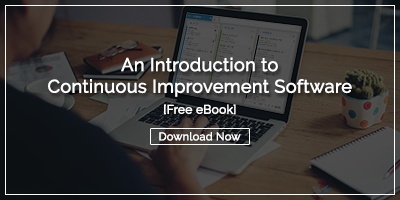(Hint: The Best Ideas Come From Inside Your Company, Not Outside)
 Does your organization have an effective method of idea tracking? Without it, ideas become vague concepts rather than concrete ways to generate improvement. Tracking an idea from inception to completion helps your employees to act upon it and see the results expressed in terms of actual impact on a variety of important measures.
Does your organization have an effective method of idea tracking? Without it, ideas become vague concepts rather than concrete ways to generate improvement. Tracking an idea from inception to completion helps your employees to act upon it and see the results expressed in terms of actual impact on a variety of important measures.
Your best ideas are going to come from inside your organization. Who knows your company and how it operates better than your employees? They’re the ones performing the day-to-day activities. They see up close what works and what doesn’t, and they have plenty of ideas about how to improve the things that don’t. Give them a forum to be heard.
By definition, implementing a culture of continuous improvement means that change will be ongoing. Idea tracking is essential to sustaining this change and creating the momentum that will result in a self-perpetuating cycle. Here are some ways to track ideas to get your whole workforce engaged.
- Employ a system that’s simple to use and accessible to all. If your method is cumbersome and difficult to navigate, it defeats the purpose right at the start. Employees will become frustrated and the tracking will be incomplete.
- Capture an idea at the moment of inception. In most companies an employee comes up with an idea but has no place to go with it. Suggestion boxes are virtual black holes. Discussion with a supervisor provides no documentation and no guarantee that anything will be done. Give your employees a means of idea tracking that allows them to submit ideas as soon as they think of them.
- Break the ideas down into tasks so that each team member knows what to do. Use idea tracking to match work flow to idea. Your employees will see what needs to be done and you’ll have a means of accountability.
- Idea tracking should include relevant communication to all involved. With daily summaries and flagged updates, employees can see the idea take shape. They’ll also have more time for action because they’re spending less time in meetings and conferences just trying to catch up.
- Documenting improvements is another vital step in idea tracking. This ties the changes in cost savings, time savings, and any other pertinent measures back to the original idea. Employees will have a visual demonstration of the impact a single idea can make, reinforcing the concept of continuous change and motivating them to seek more opportunities.
- Share the idea and its results with users of the system. Build a searchable database that can provide helpful information in the future. It also lets you and others monitor the idea for ongoing developments.
- Close the loop by going back to the beginning. Idea tracking offers a means to recognize the employee responsible for generating the original idea. This acknowledgement lets employees see their value to the organization and increases their engagement with continuous improvement.
Ideas are the dynamic building blocks for an environment of continuous improvement. Idea tracking is the tool that creates the structure. Make sure they both stand the test of time with an effective idea tracking system.



Add a Comment